MXA RACE TEST: THE REAL TEST OF THE 2023 HUSQVARNA FC450
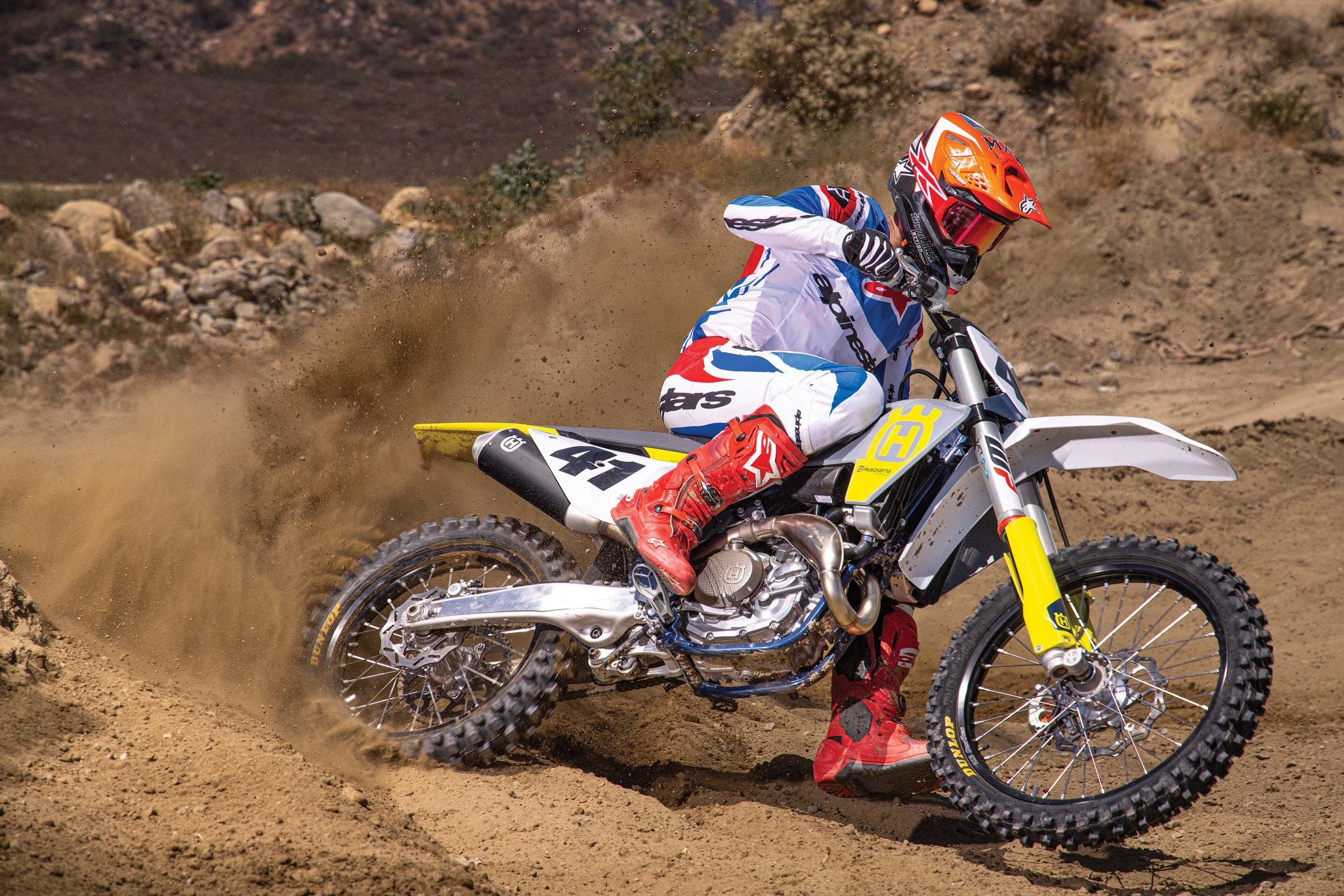 THE GEAR: Jersey: Alpinestars Techstar, Pants: Alpinestars Techstar, Helmet: Alpinestars SM10, Goggles: EKS Brand Lucid, Boots: Alpinestars Tech 10.[/caption]
THE GEAR: Jersey: Alpinestars Techstar, Pants: Alpinestars Techstar, Helmet: Alpinestars SM10, Goggles: EKS Brand Lucid, Boots: Alpinestars Tech 10.[/caption]
Q: FIRST AND FOREMOST, IS THE 2023 HUSQVARNA FC450 BETTER THAN THE 2022 FC450?
A: Yes and no, but mostly “yes,” although you have to jump through a few hoops and learn some new things to live happily ever after with it.
Q: IN WHAT WAYS DOES THE HUSQVARNA FC450 DIFFER FROM THE KTM 450SXF?
A: The color of the plastic is not the only thing that separates the Husqvarna from its KTM brother. There are 10 differences:
(1) Powerband. Although the KTM and Husqvarna share the same engine, they don’t run the same. The KTM is brisker, quicker and harder-hitting. The Husqvarna is smoother, mellower and easier to use.
(2) Forks. The Husqvarna version of the WP XACT air forks is 10mm shorter than the KTM forks. Husqvarna didn’t just stick a 10mm slug in each fork leg to shorten the length; they modified the cartridge rod and fork legs to keep the piston centered between the bushings.
(3) Shock linkage. Husqvarna wanted to lower the rear of the FC450, but they didn’t want to shorten the shock, because it had already been shortened 15mm to fit inside the more compact 2023 frame. Instead, they designed a new bell crank and linkage arms that dropped the seat height by 1 inch. Last year’s 6mm seal head cap has been updated in 2023 to a 9.5mm cap. It stops the rear tire from hitting the fender.
(4) Lower chassis. The difference between a lower Husky and a higher KTM is noticeable, most obviously to riders with inseams of less than 32 inches. During testing, MXA test riders never complained about the Husky being too low, but many complained about the KTM being too tall.
(5) Airbox. In previous iterations, the KTM subframe was made of aluminum struts, while Husky used a molded carbon/plastic, subframe/airbox combo. For 2023, both brands share the same subframe, ironically borrowing a little bit from each previous airbox and combining them into a new design using both aluminum struts and molded carbon/plastic composite.
(6) Handlebars. The Husqvarna is spec’ed with ProTaper handlebars, while the KTM uses Neken handlebars.
(7) Colors. The color palette bears no resemblance to any Husky or KTM that ever came before. It’s no longer a “white KTM.” If anything, it is a “gray/yellow/blue KTM.”
(8) Bodywork. The Husqvarna bodywork has much more rounded-off radiator wings in sharp contrast to KTM’s very pointy radiator shrouds. Additionally, for bikes that share the same frame, the Husqvarna and KTM have distinctly different gas tanks, while fuel capacity remains the same.
(9) Side panel. KTM and Husky don’t share the same side panels, which is unfortunate for Husky owners. On the KTM, the right-side panel extends up and over the shock’s compression knobs. On the Husqvarna FC450, the right side panel stops short of reaching the shock, which results in the pinwheel-style compression knobs being exposed to contact with the rider’s leg. This is a faux pas of epic proportions, mostly because this is the second time it has happened. Back in 2002, KTM had the exact same problem with a compression adjuster knob that stuck out so far that the rider’s boot would rub against it—and change the compression damping while he was racing the bike. Fast-forward to 2023, and the Kiska-designed Husqvarna bodywork failed to cover the Husqvarna shock’s compression clickers. To fix the problem, the Kiska Design firm made an ugly, slap-dash, ill-fitting and style-less piece of plastic to fix a problem that Kiska created in the first place.
(10) Front fender. The KTM front fender is designed with an I-beam reinforcement along its length, while Husqvarna’s fender does not incorporate the molded-in I-beam.
Q: WHAT IS UNIQUE ABOUT THE 2023 HUSQVARNA FC450 POWERBAND STRATEGY?
A: Corporate marketing among the three brands demands a more responsive KTM, broader Husqvarna and mellower GasGas. The Austrians found a simple and inexpensive way to produce different power characteristic out of the triplets. How did they do it? In layman’s terms, internal combustion engines use the “suck, squeeze, bang, blow” method of creating power. They suck air and fuel into the cylinder, compress it with the piston, light it with a spark, and blow the fumes out the exhaust port to make power. The more air, the more power.
As you can guess, throttle response is muted by reduced airflow, and that is exactly what the engineers at Mattighofen wanted, so the KTM airbox has larger air vents than the Husqvarna, which has larger vents than the GasGas, which barely has any air vents at all. Thus, the Husqvarna FC450 engine produces a mellower, easier-to-ride and more pleasant low-to-mid transition than its orange brother. The KTM is racier, the Husqvarna is more manageable, and the GasGas in more entry-level.
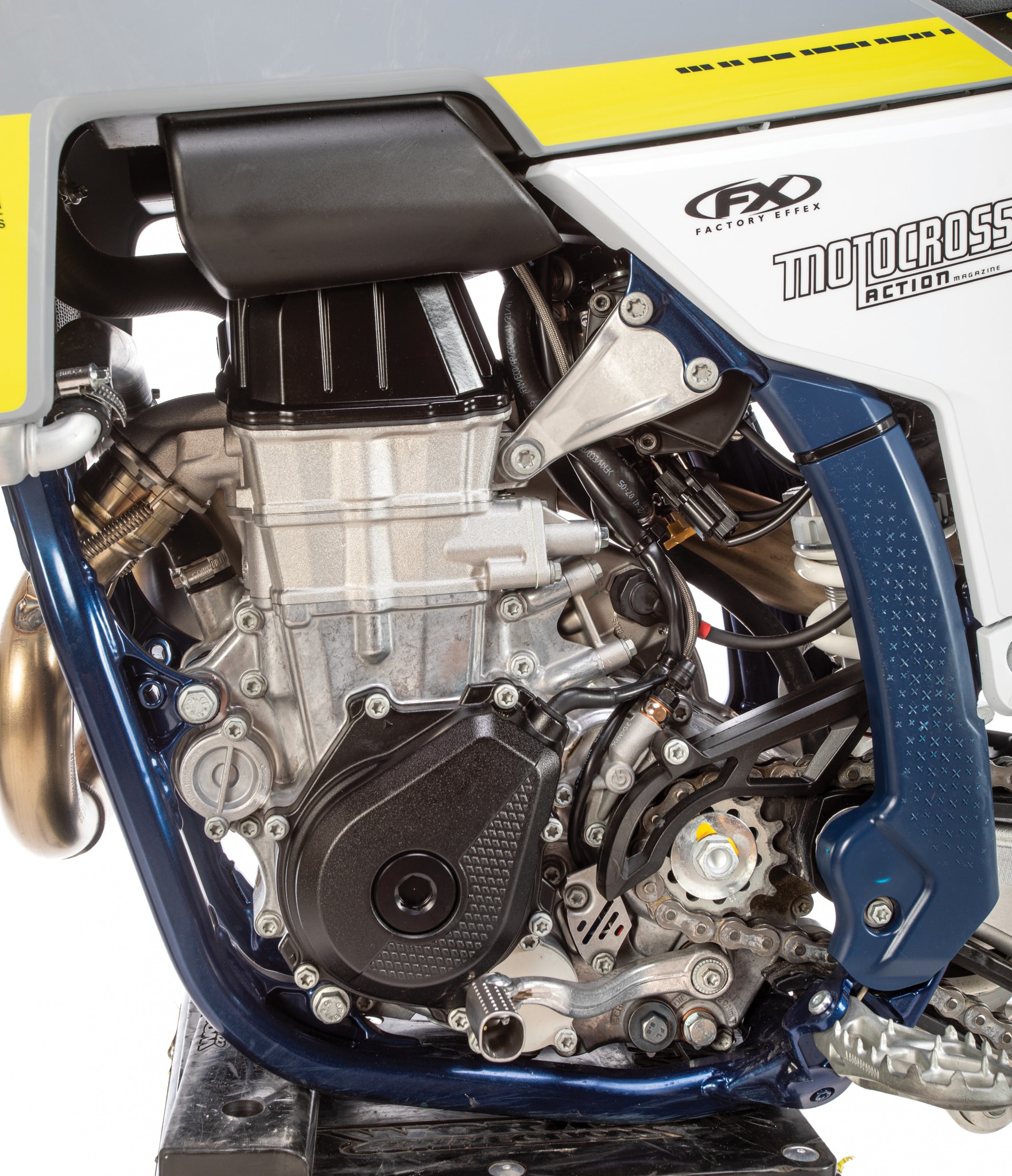 The 2023 Husqvarna FC450 engine could be as brisk as its older KTM brother or as user-friendly as its younger GasGas sibling; power production hinges on the airbox design.
The 2023 Husqvarna FC450 engine could be as brisk as its older KTM brother or as user-friendly as its younger GasGas sibling; power production hinges on the airbox design.
Q: WHAT ARE THE OTHER METHODS OF DELINEATING THE THREE BRANDS?
A: The airflow gambit is just one way that a 2023 Husqvarna FC450 differs from a KTM 450SXF or GasGas MC450F. Here are two others.
(1) Suspension. Each brand gets its own suspension setup that is spec’ed to address the marketing department’s target audience. The KTM gets firmer suspension that rides higher in its stroke and is stiff enough to take on big bumps and even bigger jumps. The Husqvarna gets the same damping and springs rates as the KTM, but both ends are lowered to make the bike more rider friendly. GasGas offers softer fork and shock valving, plus the shock has a lighter spring rate (a 42 N/mm shock spring instead of the KTM and Husky’s 45 N/mm spring).
(2) Price. The retail price of each model is chosen to produce a status barrier between the three brands, with the Husqvarna being the most expensive (because its potential audience is older and more upscale). KTM sells more units, so to keep that volume flowing, KTM undercuts Husqvarna’s retail price by $100. As for the stripped-down GasGas MC450F, it isn’t intended to compete against the KTM or Husqvarna. It is priced as close as possible to the CRF450, YZ450F and KX450.

Q: HOW GOOD IS THE 2023 HUSQVARNA FC450 SUSPENSION?
A: There are some ups and downs to the 2023 Husqvarna’s suspension setup. Here is a quick run-down.
(1) Forks. The forks have the potential to be really good off the showroom floor, but the truth is that WP has painted KTM, Husqvarna and GasGas into a corner in 2023. The 2023 WP XACT air forks are barely rideable the first time the FC450 hits dirt. They are harsh, stiff and unforgiving. How did this happen? The WP forks are set up from the factory with very tight tolerances, which is great for the long haul but horrible in the short run. The first ride on the new WP XACT AER air forks will convince you that buying this bike was an epic mistake.
However, don’t judge the 2023 Husqvarna FC450 forks by the first ride. They will get better as you put more break-in hours on them. It took the MXA test riders five hours of ride time before we were happy with the feel of the forks. Once broken in, you will be able to tune the air pressure and clicker settings to get the plushness you are looking for.
(2) Shock. WP did make some damping changes to the 2023 WP XACT shock. You will feel this as more hold up in the initial part of the stroke, which is a plus; however, as the shock gets deeper into its stroke, it seems to pick up shock shaft speed; the last 25 percent of shock travel is too soft. You could send the shock out to have it re-valved to help at the end of the stroke, but our quick fix was to increase the shock’s low-speed compression damping by five clicks. The best fix will be an aftermarket shock linkage with more rising rate at the end of the curve.
One big plus about the 2023 FC450 forks and shock is that all the compression and rebound clickers can be adjusted by hand. No need for a screwdriver to adjust compression or rebound, just turn the dials.
Q: HOW DID THE 2023 HUSQVARNA FC450 RUN ON THE TRACK?
A: The 2023 Husqvarna FC450 powerband is almost perfect for the average racer because it combines manageable low-to-mid power with forceful mid-to-top acceleration. It allows the rider to roll the throttle on sooner at corner entrance and keep it on through corner exit. It doesn’t burp, jerk or lift up. It is smooth. It makes going faster a rider option, unlike some bikes that don’t give the rider any options short of puckering up and hanging on. Most MXA test riders preferred Map 2 (the lower button on the switch).
The Husky FC450 is pleasant to ride. You don’t hear many riders talk about how pleasant their engines are to race, but Husky riders do. Pleasant doesn’t mean “slow,” more accurately it means “non-confrontational.” In short, it doesn’t bully you, fight you or try to bite you. It urges you to go faster.
Q: IS THE LOWERED SUSPENSION GOOD OR BAD?
A: Are taller handlebars good or bad? Is a seat bump good or bad? Are sharp footpegs good or bad? These are questions that only the rider who chose the bars, installed the hump or filed the teeth on his pegs can answer. There are MXA test riders who love the lowered chassis of the 2023 Husqvarna FC450. There are test riders who hated the lowered Husqvarna suspension, but when they switched to a 2023 KTM 450SXF, they complained that it was too tall. You can’t please everyone!
There is no denying that science is on the side of the riders who love the way the Husqvarna FC450 handles. Thanks to its unique setup, it can do some magical things on the track—aided in no small part by the Husqvarna’s new chassis, lowered riding position and “pleasant” roll-on power. The FC450 can carve through deep ruts with ease and glide over braking bumps and whoops, thanks to the anti-squat characteristics (supplied courtesy of the 3mm-lower countershaft sprocket). You can feel the Husqvarna’s improvements in lean-angle traction, rear-wheel connectivity and power transfer.
For Vets and older riders, the 2023 Husqvarna is a godsend in the handling department—once you get through the 10-hour frame break-in period that seems to have come straight from Hades.
 The Husqvarna map switch is simple—two switches for maps and two buttons for Traction Control (TC) and Quick Shift.
The Husqvarna map switch is simple—two switches for maps and two buttons for Traction Control (TC) and Quick Shift.
Q: WHAT DID WE HATE?
A: The hate list:
(1) Chain slack. Set your chain slack at 70mm. If you don’t, your chain will be too loose and whip like a runaway roller coaster. Keep an eye on the chain buffer pad for wear.
(2) Seat bolt. Do you remember how the radiator wing bolts used to seize in the riv nuts molded into the gas tanks of the 1980s two-strokes? The same thing can happen to the front-mount seat bolt if you tighten it too much.
(3) Wheel spacers. Sadly, you can’t run your older spare KTM or Husky wheels on the 2023 models. You have to change the seals and spacer tube on the pre-2023 wheels to work with the new, smaller axle and longer, plug-in wheel spacers.
(4) Shock cover. This cover is an afterthought. With better designers, it wouldn’t have been necessary.
(5) Finding neutral. Getting the transmission into neutral on the starting line is hard. We rev the engine really high with the clutch pulled in and then snick it into neutral as the revs fall off.
(6) Weight. Although it is still lighter than all the Japanese 450s, it isn’t as light as it was in 2022, by 4 pounds.
(7) Spokes. Husqvarna claims to have new spoke nipples that won’t come loose. We must have gotten the only bike with spokes that do come loose.
(8) Shock linkage. On an undetermined number of Husqvarnas and KTMs, the needle bearings in the shock linkage walk out and bind up the shock linkage. MXA replaces the needle bearings with a new caged bearing (KTM part number 58033097000).
(9) Airbox. The Husqvarna looks like it has large, KTM-style, airbox vents just below the seat on both sides of the bike, but it doesn’t. Husqvarna’s airbox vents are molded shut. Luckily, Husqvarna has an optional vented airbox cover that improves throttle response.
Q: WHAT DID WE LIKE?
A: The like list:
(1) Seat height. We think every brand should bring their seat height down.
(2) Brakes. The Brembo brakes are both powerful and well-modulated. They are awesome!
(3) Shock collar. The new shock collar is much easier to turn.
(4) Quick Shift. Great for long high-speed starts, it can be quirky in half-throttle situations, especially on jump faces.
(5) Air filter. The easiest filter to change. Plus, if you look closely at the top center of the cage, there is an embossed arrow to tell you which end is up (and a corresponding arrow on the Twin Air filter).
(6) Handling. Thanks to a lower center of gravity, the Husqvarna corners like a dream.
(7) Idiot light. In 2022, the FI diagnostic’s LED light fell out of its holders constantly. For 2023, the idiot light has been moved to the hour meter.

The all-new footpegs don’t stick out any farther than last year’s, but they are recessed into the frame to increase the size of the footpad.
Q: WHAT DO WE REALLY THINK?
A: MXA is always wary of first-year models, and the 2023 Husqvarnas and KTMs are first-year models. If you are new to Husqvarna or looking for a race-ready bike right out of the crate, KTM and Husky aren’t for you in 2023. Hard core Husqvarna racers will take the long break-in period of the forks and chromoly chassis in stride. And once the break-in time is reached, they will be rewarded with the most technically advanced Husqvarna ever.
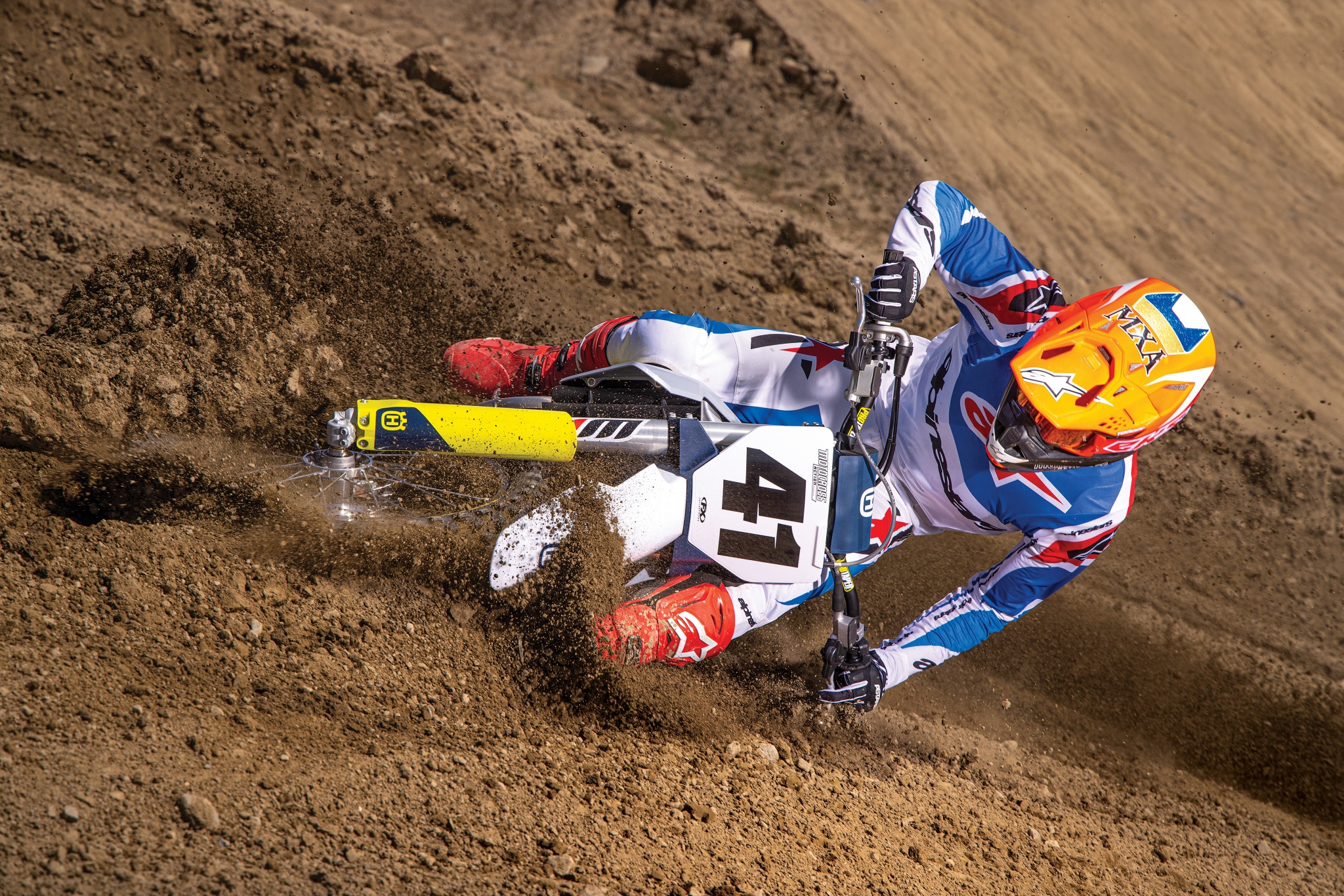 The 2023 FC450 frame is stronger and more rigid than the 2022 frame. Luckily, chromoly steel is resilient and will break-in over time. How long does that take? Ten hours.
The 2023 FC450 frame is stronger and more rigid than the 2022 frame. Luckily, chromoly steel is resilient and will break-in over time. How long does that take? Ten hours.
MXA’S 2023 HUSQVARNA FC450 SETUP SPECS:
This is how we set up our 2023 Husqvarna FC450’s suspension for racing. We offer it as a guide to help you find your own sweet spot.
WP AER FORK SETTINGS
Step one is to try to put as much time on the forks as possible, at least five hours, when they are new before worrying about how they perform. We guarantee that they will be terrible. Once they break-in, they will work fine. For hard core racing, we recommend this fork setup for an average rider on the 2023 Husqvarna FC450:
Spring rate: 158 psi (Expert), 152psi (Intermediate), 145psi (Vet), 138 psi (Novice)
Compression: 14 clicks out (12 clicks out)
Rebound: 15 clicks out (18 clicks out)
Fork-leg height: Third line
Notes: There is a learning curve to getting the most out of the WP XACT air forks. The right fork leg is strictly damping, and the left leg is air only. Husqvarna has a sticker on the air leg to guide you to the recommended air pressure. It is a good starting point, but it’s just a suggestion. MXA has test riders who run as much as 165 psi and test riders who run as low as 135 psi. Do not play air-pressure roulette by trying to change the damping characteristic with different air pressures. The 2023 forks have the potential to be great.
WP SHOCK SETTINGS
Most MXA test riders liked the overall feel of the WP rear shock, especially after Husqvarna lowered the shock spring rate in 2017 from 48 N/mm to 45 N/mm. WP did make some technical changes to the 2023 WP XACT shock to make the damping stiffer initially and, unfortunately, softer at the end of the stroke. For hardcore racing, we recommend this shock setup for the 2023 Husqvarna FC450:
Spring rate: 45 N/mm (for 175 and up pounds), 42 N/mm (for riders under 175 pounds)
Race sag: 105mm
Hi-compression: 1-1/2 turns out
Lo-compression: 10 clicks out
Rebound: 15 clicks out
Notes: We asked WP for an inexpensive solution to the rear shock blowing through at the end of its stroke. They suggested that more low-speed compression would be better (not perfect, but better). The Husqvarna needs a different rising rate curve—one that changes the rising rate at the start of the stroke to be a little softer but then ramps up at the end of the stroke to be stiffer. The aftermarket will fill this void quickly.


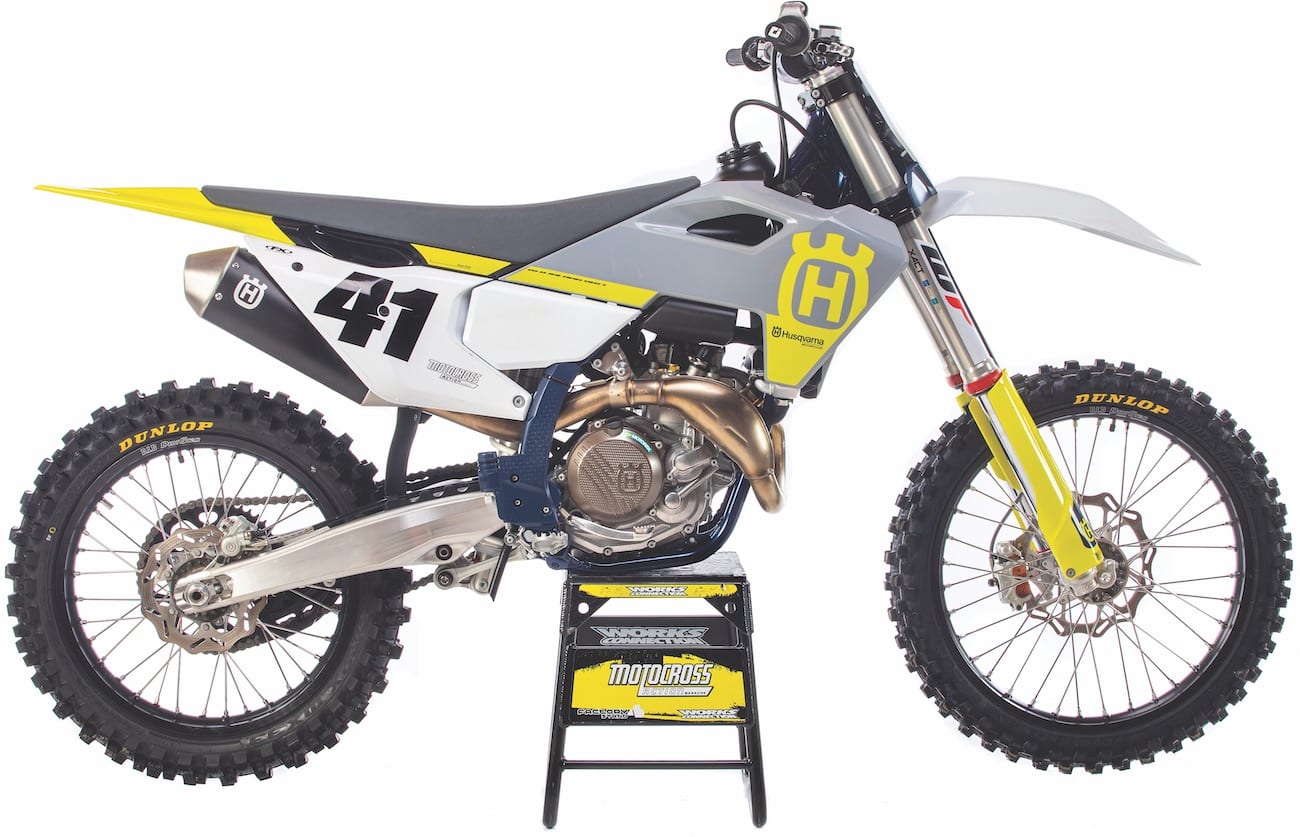
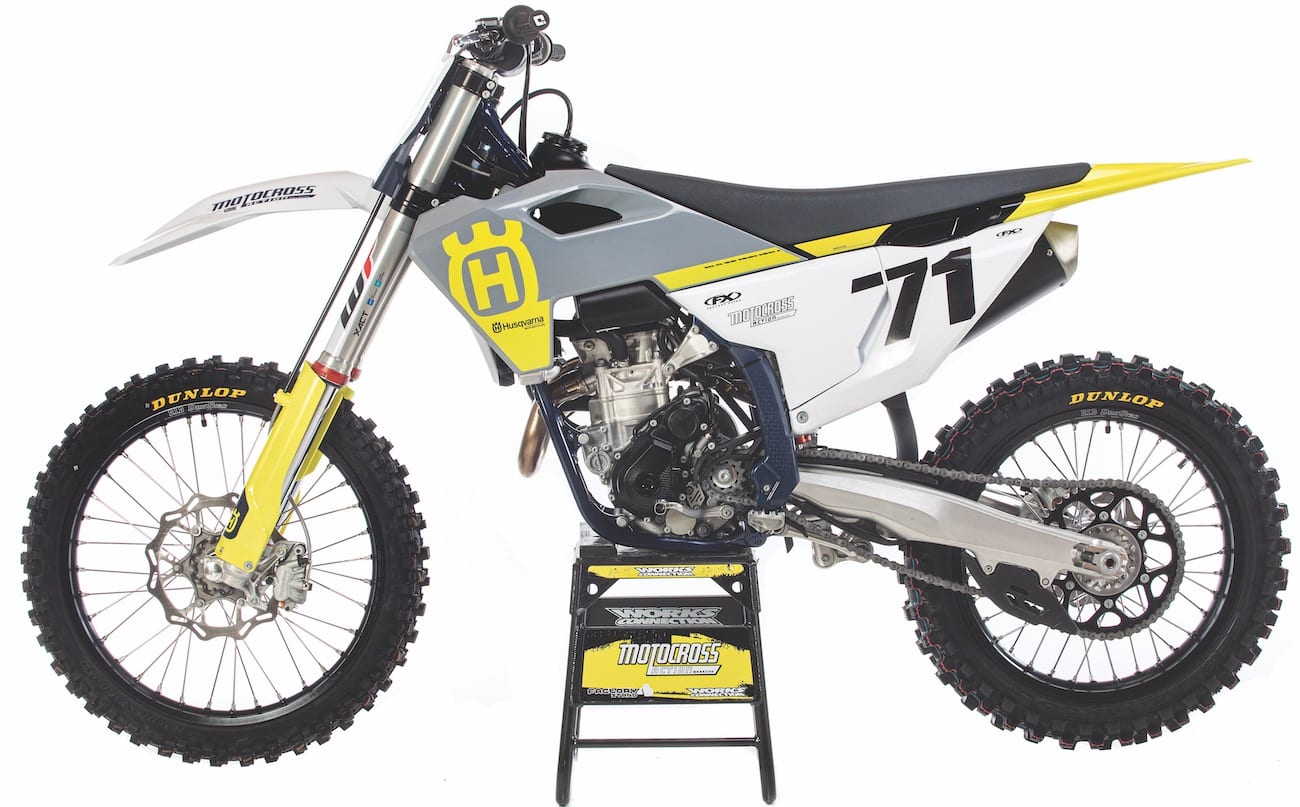
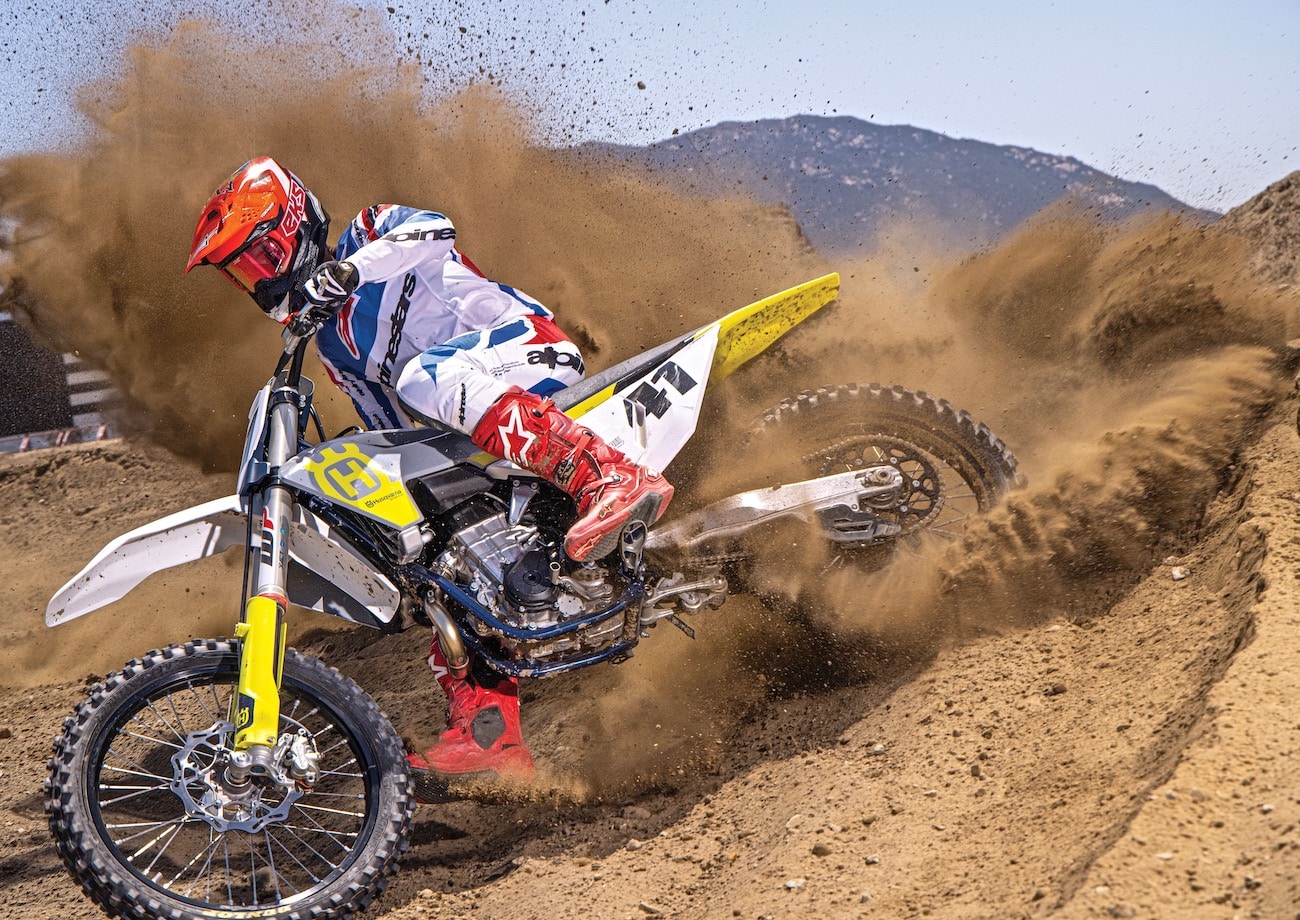







Comments are closed.